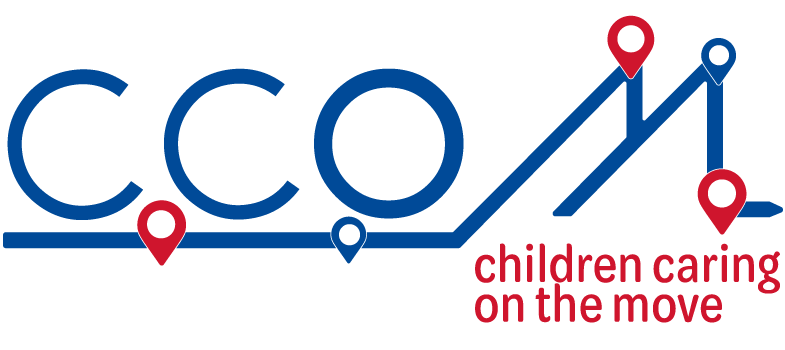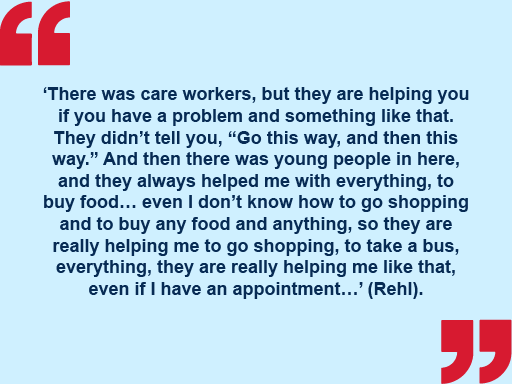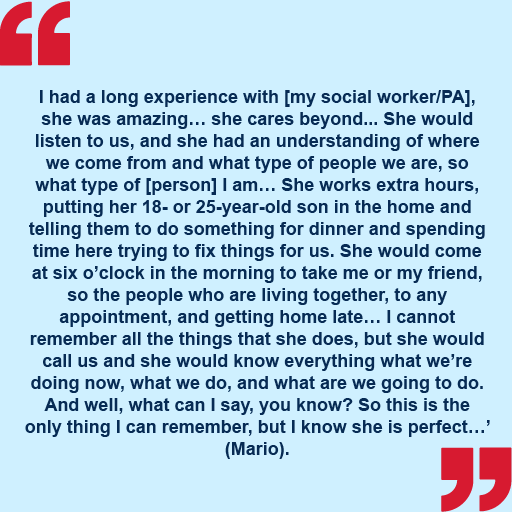5.2: Young people’s care practices and caring relationships
The Children Caring on the Move research suggested that ‘care’ means lots of different things to different unaccompanied young people. Young people talked to us about their relationships with other young people, and how they care for each other (see also Section 3.2 [Tip: hold Ctrl and click a link to open it in a new tab. (Hide tip)] ). Sometimes, young people take a ‘family-like’ role, and other times they become mentors/advisors to other young people. Clearly, there are also important relationships with social care professionals and other key adults. Let’s watch the second segment of film.
 Activity 5.2: Seeing ‘You’
Activity 5.2: Seeing ‘You’
In the second half of the film, the young people talk about the variety of relationships they have with other young people and adults. After watching the second part of the video, draw a mind map on a piece of paper, depicting the relationships with significant others these young people talk about and reflect on the following:
- What made them important?
- What do you think young people value as caring in these relationships?
Transcript
Discussion
You may have noted that the clip can be split into three broad areas:
- Disruption to relationships.
- Developing care relationships with other young people.
- Developing relationships with adults.
It is clear from this clip that establishing relationships with other young people is an incredibly important part of their experience. However, a disruption to the continuity of these relationships can have a negative impact.
You may have got a sense of how significant their care relationship with other young people can be. For example, one young person felt very alone when they arrived in the UK, but in establishing relationships realised there was a lot of potential in the development of a new self in a new context – being someone new and ‘doing more’ with the support of other young people.
Not surprisingly, adult relationships, when positive, were extremely impactful. Hopefully, you noted that a positive adult relationship was framed in terms of kindness or being ‘lovely’ and being present or helpful – someone who ‘checks-in’ and are part of the key processes such as Home Office interviews. Someone to turn to, to manage challenging situations. Arguably, these are small but important acts of care.
But, when relationships were negative, you may have noted a link with racist attitudes and, in difficult relationships, nowhere to turn. The young people also recognised that social workers were overburdened with cases, making care challenging.
As mentioned earlier, a key focus on the CCoM project was to explore the experiences of young people’s care of each other. Building trust and relying on other young people for care was one example mentioned by one of our interviewees. Rehl describes how the young people in their shared house engage in a range of small acts of care:
If we reflect on the phases and moral elements of care that you explored in Section 2.1, these small acts of support come under the phase of ‘caregiving’ and ‘competence’. The young people in Rehl’s house were able to share their own learned competences and, in turn, were providing everyday forms of care.
Whilst we tend to hear, or focus on, the most negative stories about the relationships between young people and the adults in social care situations, some of the young people in our study did mention the acts of care that they valued from adults. Mario discusses this in this next quote:
As we know from Section 3.2, going above and beyond like the social worker in this quote can be emotionally draining and demanding.
 Pause for reflection: reflection on multiple stories
Pause for reflection: reflection on multiple stories
As you reflect on these discussions, what care practices do you engage in? What are the limitations or boundaries that you set and why? Have these stories affected the way you see and work with UASC?
Make some notes in the box below.
5.1: Making the film


